The pickleball kitchen rules are crucial to understanding to make the play enjoyable and a victory situation. Sometimes, most beginner players lose points just because they don’t know the kitchen rules.
Consequently, you can make a great score in pickleball by knowing what exactly the Kitchen is and what are the pickleball kitchen rules to get them. So, let us dive into the detailed guide to know what the Kitchen in a pickleball is, its rules and its synonym.
What is the Kitchen in Pickleball?
Although the Kitchen in pickleball is not so common, it is not a critical term to understand.
Since many beginners don’t have an idea about the Kitchen in pickleball, they miss good chances of making a victory in the game.
That is why you should first make yourself aware of all the terms related to pickleball if you really want to make a name in this play.
Now, let us know what is the Kitchen in pickleball.
So, the Kitchen is basically a non-volley zone area in the pickleball court. It is about a seven feet area away from the net on both sides of the court and white lines represent it stretching along the sides.
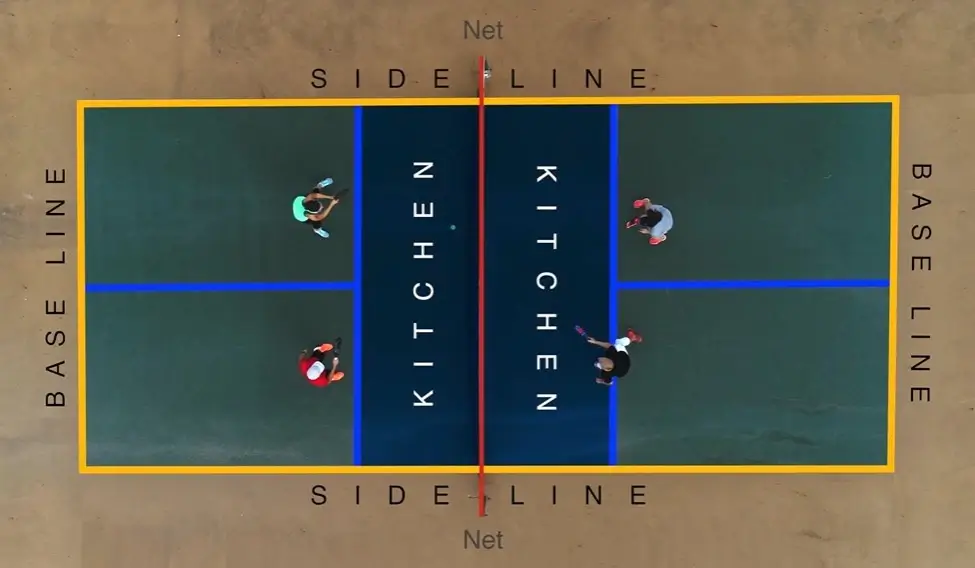
You can guess the purpose of the Kitchen in pickleball from its synonym term “non-volley zone”.
In this way, the purpose of the Kitchen is to avoid volleying in this area. Accordingly, it also prevents the players from standing very close to the net to stop the ball’s downward hit for a win-win situation.
However, if the serve lands on the boundary or within it then it is a fault. In this case, your opponent wins a point.
It would help if you also kept in mind that the Kitchen doesn’t mean the above space behind the seven feet from the net.
Instead, it just means the physical area of the non-volley at a seven feet distance.
Because of this, it is completely legitimate to hit the ball above the Kitchen without touching the kitchen boundary.
Where does it exist on the pickleball court?
The kitchen in pickleball is just like a private IT room of your college where the student’s entry is strictly prohibited.
The players cannot enter the kitchen until the ball bounce, and it’s a fault.
Top 5 Pickleball Kitchen Rules
To have a wonderful pickleball experience, you must know the essential kitchen rules. Besides the serving rules, the kitchen rules are crucial because the whole pickleball mostly depends upon the Kitchen.
So, with that said, let’s conceal the rules of the Kitchen in pickleball.
1. No volley zone
The first and foremost rule of the Kitchen in pickleball is to stay outside the non-volley zone. You know that you cannot score points in the Kitchen.
Some beginner players keep asking if they can hit the ball in the Kitchen in pickleball or not.
The answer to this question is no. That is why you should never touch the Kitchen on the ground when a ball is landing there.
2. Kitchen Boundary Lines
The lines play an essential role in pickleball because they are the marks showing the restricted area.
You can do volleys by standing away from the kitchen boundary line. The volley term means smashing the ball before it touches the ground.
If somehow, unfortunately, you touch the boundary line in a try to strike the ball, then it will be considered a fault, and you will lose the point.
It is also essential to know that you should avoid touching the kitchen line even when the serve lands on your opponent’s side.
3. Kitchen Entry Rule
This rule will clarify your query about when you can go in the Kitchen for pickleball.
So, let’s know that you can enter the Kitchen whenever you need but with the condition that you must not hit the ball there.
If you are in the Kitchen and the serve is landing, you should take both of your feet out of the Kitchen to make an excellent shot.
Also, it would help if you remembered not to strike the ball even in the air when standing in the Kitchen.
It could be beneficial to know that you can only strike the ball after two shots.
However, you can make the groundstrokes within the Kitchen in pickleball. The groundstroke term means hitting the ball after it has touched the ground.
So, if you want to know when can you step into the Kitchen in pickleball? Then this rule helps you by following the above guidelines.
4. Serve landing in the Kitchen in pickleball rule
Can a serve land in the Kitchen in pickleball? It is one of the most common questions and is also one of the crucial rules of the Kitchen in pickleball.
The answer to this question and the rule is that the serve cannot land in the Kitchen. If the serve lands in the Kitchen, you will lose the point and definitely go towards the opponent.
If somehow the ball comes over the non-volley zone but touches the boundary, you cannot volley the ball until you get back to the normal court area.
With that said, you should focus on this kitchen rule if you are a beginner or someone who wants not to make a mistake in pickleball.
5. Take Help From the Partners.
Sometimes, when you are about to volley, you touch the kitchen line due to the instant momentum.
Although you were in a hurry, this act of you can lead to a fault in the play, making you lose points without your knowledge.
In this scenario, your partner proves handy. Yes! You heard right.
Well, your partner can help you from touching the non-volley line by holding you back.
It really proves to be a valuable rule for making the points in rush hour without entering the Kitchen.
You may be surprised to know that you will lose a point even when any of your accessories or body parts other than your legs touch the kitchen line.
So, in this case, your partner can help you by preventing kitchen entry.
Where is the Kitchen in Pickleball?
On the pickleball court, the kitchen is parallel to the net and is approximately 7 feet away from it. The kitchen exists on both sides of the pickleball court.
The lines drawn for the kitchen are assumed to be a part of the kitchen according to official rules.
As stepping in the kitchen is crime, likewise stepping on or touching the lines is also offense.
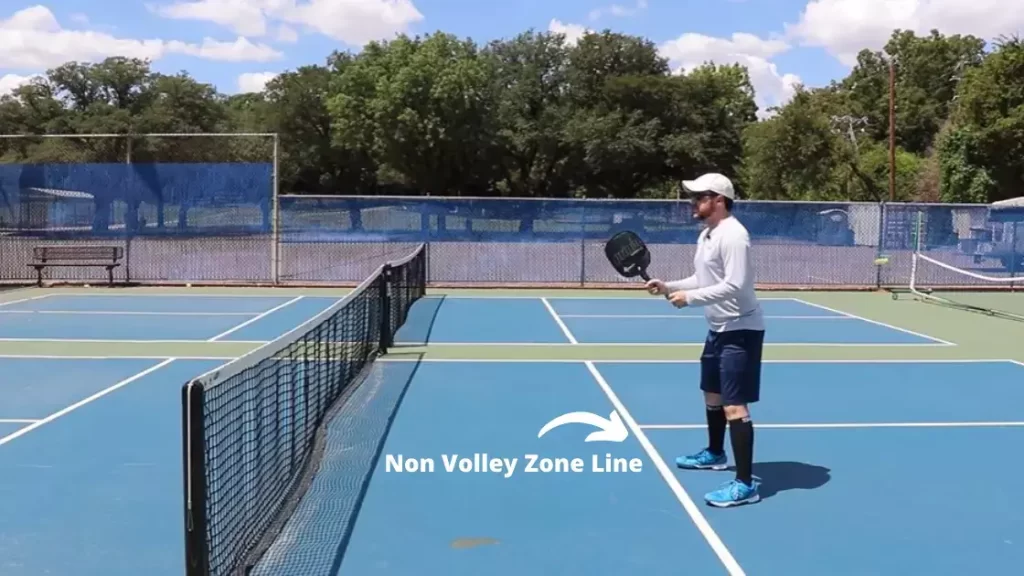
How Big is the Kitchen in Pickleball?
As you know, a line represents the Kitchen in pickleball on both sides of the court. So you may now wonder how big the Kitchen in pickleball is.
Accordingly, the Kitchen area is about seven feet from both sides of the net and covers approximately twenty feet parallel to the net. In the same way, the width of the kitchen line also matters. So the boundary line of the Kitchen is two inches wide.
The non-volley area is designed to keep the players at a distance from the net, so the play remains smooth.
As the rules must be equal for everyone, the non-volley zone covers a similar area from the serving and returning team’s sides.
Pickleball Kitchen Size
Let’s discuss how much it covers? The dimensions of non-volley zone are,
- 7 ft. (from both sides of the net)
- 20 ft. wide
It means the kitchen covers 14 ft. area of the pickleball court. It might let you think that, why this much area is only constructed to avoid during game?
Don’t worry, we will tell you when you can step in and how this area worth it.
Why the Kitchen Exists? Is there any Purposeful Concept?
The fundamental reason for developing the kitchen area in pickleball is to avoid hitting balls in this area.
You can understand it better by supposing a situation like how pickleball can proceed if two players stand very close to the net.
Obviously, it cannot because you need a considerable distance to smash the ball. That is why the Kitchen was discovered to make pickleball a convenient play.
This idea came to the inventor’s (Joel Pritchard, Barney MacCallum, and Bill Bell) minds to adjust the constant hard hits in a smooth play. Its existence helps to eliminate the smash or stiff types of collisions.
As you are familiar, this play is for all age groups, specifically the old ones, so it was necessary to eradicate hard hits like squash, badminton, and tennis.
You probably have seen the old players on wheelchairs playing pickleball. The hard hits and smashes in other games resist them from playing it. But, in pickleball, every old man/women play and enjoy it.
What is Another Name For the Non-volley Zone in Pickleball?
It’s a reality that in the beginning most players don’t know the basics of the play.
You can have a good idea by knowing that beginners are so unfamiliar with the “kitchen in pickleball” term that they get confused when someone asks them what the non-volley zone in pickleball is.
Well, I’d like to inform you that these two terms have nothing different.
The other name for Kitchen in pickleball is the non-volley zone in pickleball. So the non-volley zone is nothing complex but another name for the Kitchen in pickleball.
To make it amusing, the kitchen is a unique term for the non-volley zone. Joel Pritchard and his team named the kitchen as they named Pickleball uniquely.
The non-volley zone is sometimes also declared as a no-volley zone. Please don’t get confused with it; it has three different terms for the same concept.
The players can’t step into the non-volley area until the ball bounce. Stepping in still will make you stuck out of the game.
Why is it Called the Kitchen in Pickleball?
It seems an interesting query; I saw many people curiously wanting to know,” why a no-volley/non-volley zone names the kitchen?” There are multiple reasons for it.
To be honest, there are many stories related to the Kitchen in pickleball. Some say that since three dads discovered pickleball they gave the non-volley zone the name of Kitchen because they found it interesting.
You might also hear the story of shuffleboard. If non-volley zone naming clichés you a lot, you are at the right place to know the many possible motives for calling it.
Let’s take a closer look into it.
Mutual Collaboration of Three Dads
As you know, pickleball inventors are three Dads, Joel Pritchard, Barney McCallum, and Bill Bell, so some of us believe that they named pickleball uniquely like the kitchen.
They just added a silly name to make it especially interesting for their children.
Story of Shuffleboard
You might have heard about it before, but most professionals believe that is the true motive.
What’s it? Shuffleboard is a 2-4 players game in which a 10-off zone exists, which resembles the non-volley zone rules to some extent.
The kitchen or 10-off zone in the shuffleboard exists behind the shooting/scoring area. This area is about 1 and 1/2 ft beyond the shooting area.
The rule is “stepping into the 10-off zone area will result in loss of 10 point “. Likewise, pickleball also does not allow its players to step into Kitchen.
I know what your mind is thinking now!
Did shuffleboard adopt or copied the name from pickleball, or did Pickleball? Its pickleball, as shuffleboard came into existence in 1913 prior to pickleball.
The phrase
Pickleball came into existence on a hot summer day, the days in which visiting the kitchen was troublesome for everyone.
It might refer to the phrase “when you cannot take the heat, get out of the kitchen.” These are the different views of people.
As many chronicles as there are, bards!
It seems interesting, but in my view, there is nothing to ponder too much as you can never know how it got its name.
Non Volley Zone Faults (Examples)
Let me make a wild guess that usually, you run towards the kitchen area to not miss the volley. Although you are trying your best to make a shot, you are making a fault instead of winning a point.
So here let’s quickly go through some of the common non-volley zone faults for improving your play.
1. Running into the Kitchen to Hit a Volley
So here goes the first fault of the non-volley zone you make unconsciously. It is a fault if any part of your body or anything you carry should move into the kitchen or touch the kitchen line.
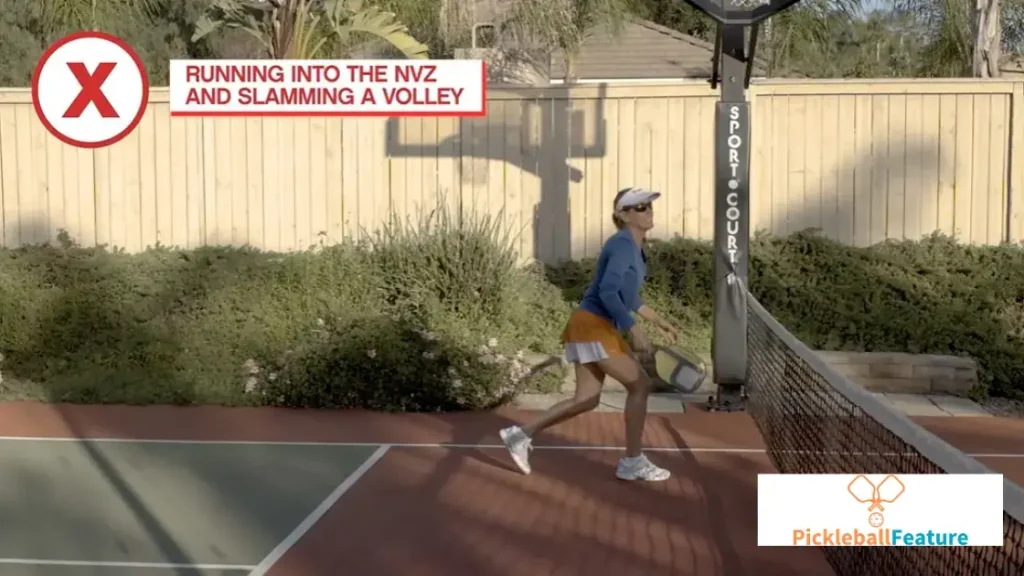
However, you can run into the non-volley zone for hitting the volley only when the ball bounces. Moreover touching even the line during volleying is a fault.
2. Paddle Touching the Non Volley Zone
Did you ever know before that your paddle in the kitchen can bring you to a fault?
Yes!
As we talked about dropping anything you carry in the non-volley zone is a fault. Similarly, it will be a fault if you drop your paddle in the kitchen when volleying or if your paddle, unfortunately, contacts the kitchen.
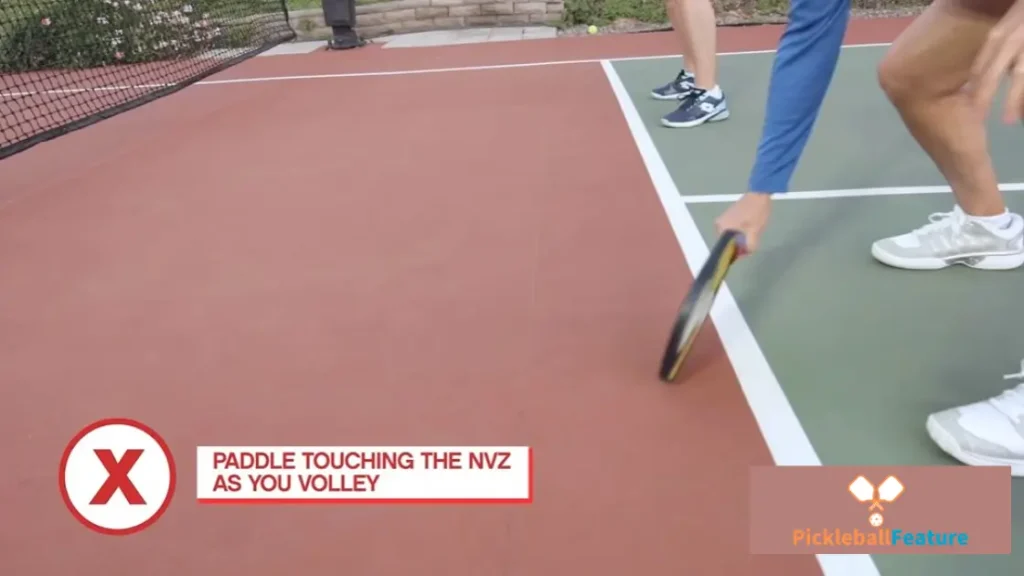
3. Dropping Anything into the Non Volley Zone
Let us jump into another most usual fault of the non-volley zone.
Accordingly, you should not drop anything you touch into the kitchen when you hit a volley. Additionally, it’s a fault when you unconsciously enter the kitchen following the ball. Similarly, you can’t even drop your partner’s paddle into the kitchen.
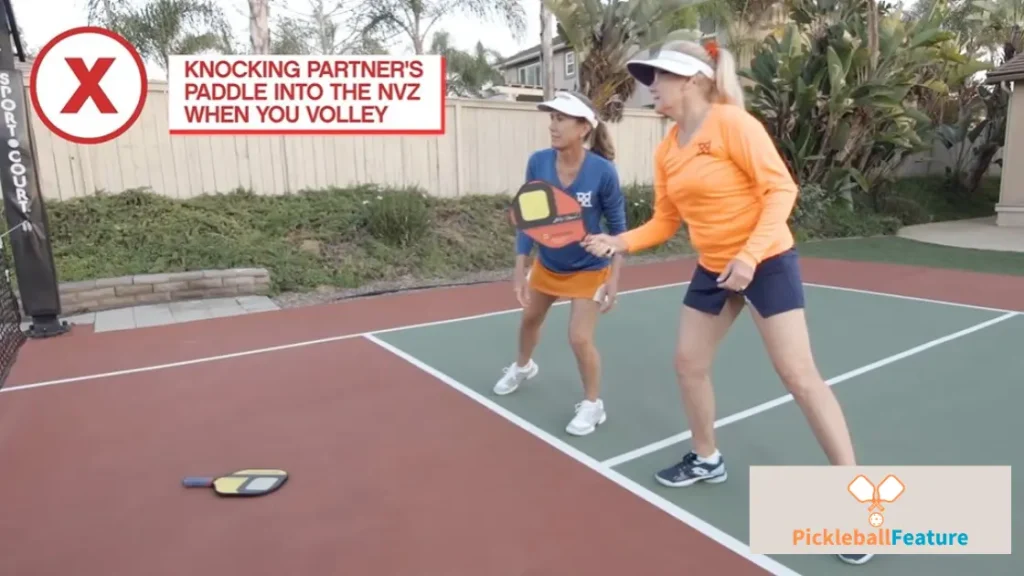
When you volley, you must not knock your partner’s paddle into the non-volley zone. Similarly, pushing off your partner who is in the non-volley zone is also a fault.
But if you touches your partner who is outside of the non-volley zone then there is no fault.
If you’re moving towards the non-volley zone and your momentum pulls you in, that’s a mistake. It’s a fault even if you just step into the kitchen out of habit.
4. Use of Hand to Keep Balance
You can take help from your partner to avoid touching the non-volley zone if they are outside the kitchen. But not when they are inside.
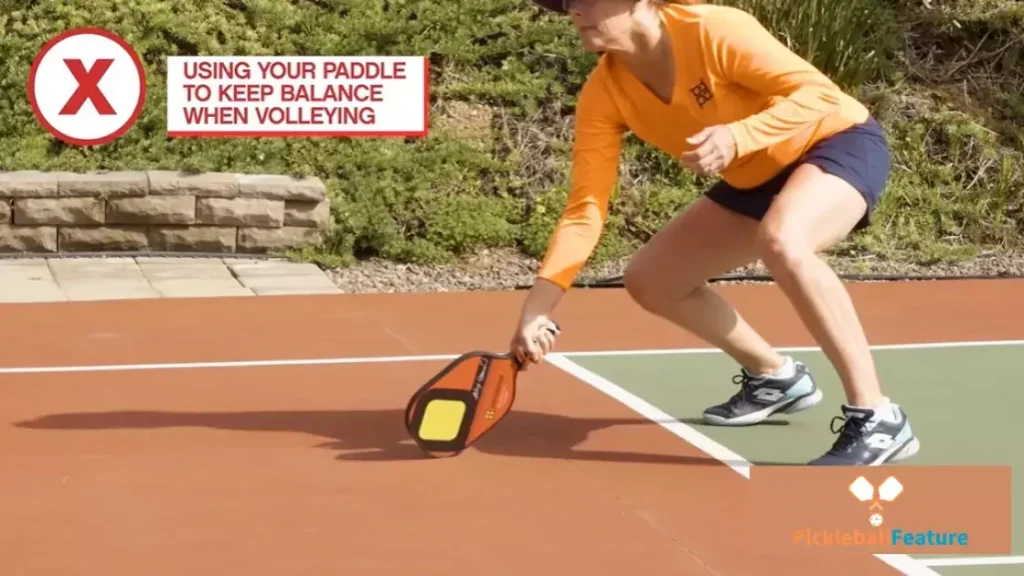
To put more light on it, it’s a fault when you use your hand or paddle to balance your position. Besides, it is also a non-volley zone fault if you get out of the balance and enter the kitchen after volleying.
5. Starting from inside the non-volley zone
You should know that volleying in the non-volley zone before jumping outside is a fault. Likewise, it’s a fault if you are outside the kitchen but during volleying, any of your feet touch the kitchen line.
You make a fault if you run towards the corner of the non-volley zone to volley, but any of your feet touch the kitchen.
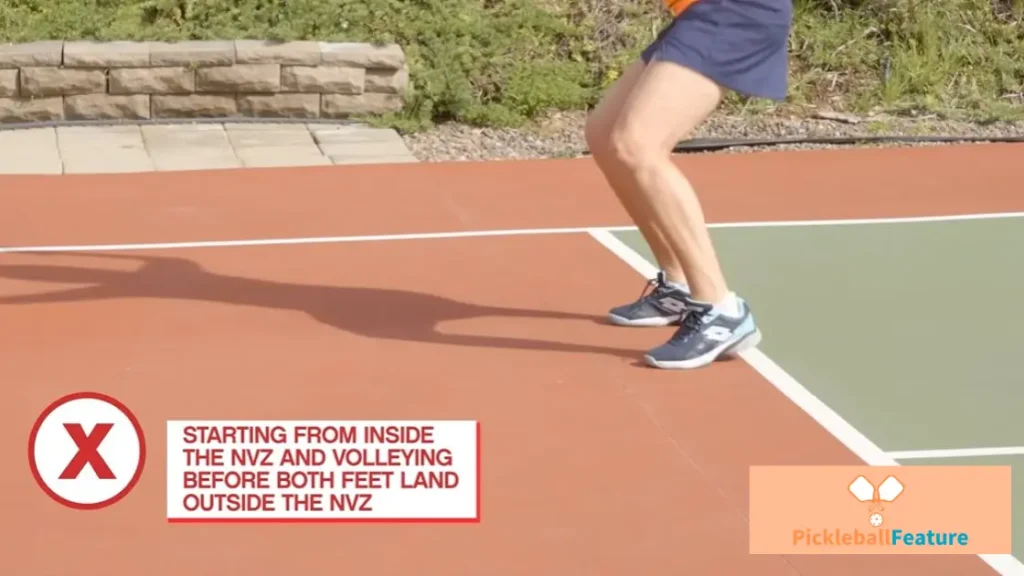
Frequently Asked Questions
Let’s clear your queries most simply. Whenever we physically attempt coaching, the juniors and beginners ask these questions. I know through interpreting it, many of your questions will be answered.
Let’s jump right into it.
1. Can You Hit the Ball in the Kitchen in Pickleball?
If the ball bounces, then you can hit the ball in the non-volley zone. The players cannot volley by standing in the non-volley spot.
Standing in the kitchen in-game is not prohibited, but you are advised to maintain yourself outside the non-volley zone.
If you stand in the kitchen for a long time, you may hit the volley unintentionally, and there is no warning for playing again.
2. When Can You Go to the Kitchen in Pickleball?
You can visit the non-volley zone throughout the game until you are not volleying. Standing in the kitchen for a long time is in your opponent’s favor as it’s crucial to get out of it abruptly.
When I was learning pickleball techniques from a professional Pickleball coach, he once said, “Better to not take the heat of kitchen, especially if you are an average player.”
From this day onward, when I tried to step in, I ceased myself for not doing it. So, I advise you the same about it.
3. When Can You Step into the Kitchen in Pickleball?
Whenever we talk about the non-volley zone, we always encounter the statement, “it’s a fault to step in it, even to touch the line.” Because of this, everybody is curious, when can we step into the kitchen, or it’s never allowed for players?
Take it, easy peeps; you can step into the non-volley zone when you are not volleying. You can hit the ball if it has bounced first.
4. Can a Serve Land in the Kitchen in Pickleball?
No, it’s a fault.
If your serve lands in the Kitchen, the point will be in your opponent’s favor. You cannot let your serve land in a non-volley zone. The serve must land in the service box instead of the non-volley zone.
It simply means you are volleying in the kitchen if your serve lands in the non-volley area.
In this situation, one point will be given to your opponent. Be careful; your serve should touch the pickleball net and be in the appropriate service box.
5. Can the Return of the Serve in Pickleball Land in the Kitchen?
Yes, the return of the service has no boundaries for the non-volley zone. It can land in the kitchen; the rules are only for the serves or volley.
It’s not complicated, and It is cleared by its name “non-volley zone” that you have not to volley in this zone. Everything is permitted, stepping in and hitting the ball after bounce except volleying.
6. What Do You Mean by the Dead Ball in Pickleball?
In simplest terms, the dead ball means the shot which earns you no score. Such as if you don’t follow the rules of pickleball, then you may earn a fault in the play. It means that your score will go to your opponent or will not be considered, depending on the situation.
The dead balls could even eliminate you from the pickleball if you don’t work on correcting them.
7. Why Do You Play Pickleball at the Back of the Court?
I want to be straightforward. Due to the Kitchen, pickleball is played at the back of the court. This is due to the possibility of accurate regulatory compliance.
Final Thoughts: Pickleball Kitchen Rules
At this point, now you know that the kitchen is also called a non-volley zone. Additionally, this article gives you an idea that you can enter the Kitchen when not hitting the volley.
After reading this article, now you understand that it’s legal to take help from your partners to make a perfect shot. They can do it by preventing you from touching the kitchen line. Moreover, do not let your serve land in the Kitchen of the opponent. In short, the kitchen pickleball rules guide makes you understand all the essential pickleball terms in detail.

I am Michael Wanner, an experienced and educated expert in the field of pickleball. I hold a degree in Sports Science from Cleveland State University, Ohio, USA. My expertise lies in the technical aspects of pickleball and how to play it effectively. I have spent many years playing and coaching pickleball and have a wealth of knowledge to share with my readers. I am a valuable resource for anyone looking to improve their pickleball skills and strategies.